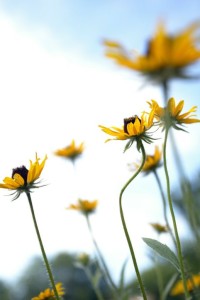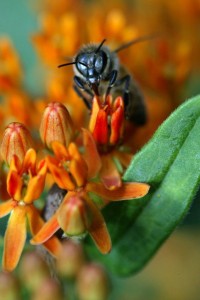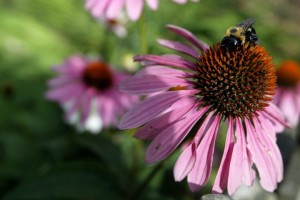April is a great month to get plants in the ground that “service” pollinating insects. Most commonly, we think honeybees when we think about pollination, but there are plenty of native bee species that do that work, too. In particular, bumblebees are great pollinators. Native bees are very important these days because of the devastation of honeybee populations by the colony collapse disorder.
Planting patches of bee-friendly habitat will help pollinating insects do their work. Including a wide range of species that bloom successively over an extended period of time will ensure that pollen and nectar are available to insects throughout the year. These “patches” can be planted almost anywhere: along the “edge” where the woods meet open land, as field borders or buffer strips between fields and/or in perennial beds. In addition to providing habitat for pollinating insects, they serve as refuge for other beneficial insects, predators and parasites, which help to control insect pests in crops.
Use native plants when possible. Ideally, three native perennial species that are spring bloomers are planted together with three summer bloomers and three fall bloomers. Species with different colors and shapes are desirable. For small plantings, use nursery-produced perennials in pots. For larger plantings, seed for many perennial species is available and can be sown by hand or with a spinner. Most of seeds of recommended herbaceous perennials are very small. Rather than try to cover the seeds with soil after spinning them out, use a roller or cultipacker to “press” the seed into the soil and ensure good seed/soil contact. Small seed buried too deeply is not likely to germinate and emerge.
Of course, seedbed preparation is important. A finely tilled seedbed is likely to get the best results. As plantings can be expected to provide good foraging for bees and others for up to five years, elimination of any perennial competitors such as bermudagrass, kudzu, johnsongrass or hairy vetch is a good idea.
Some of the more common herbaceous perennials that growers sow from seed to  establish benefical/pollinator habitat include: Joe Pye weed (Eupatorium spp.), Boneset (Asclepias perfoliatum), Milkweed (Asclepias spp.), Goldenrod (Solidago spp.), Swamp sunflower (Helianthus angustifolius), Wild indigo (Baptisia spp.), Wild blue lupine (Lupinus perennis), Oxeye daisy (Heliopsis helianthoides) Black-eyed Susan (Rudbeckia hirta), Lance-leafed coreopsis (Coreopsis lanceolata), Purple coneflower (Echinacea purpurea), Stokes aster (Stokesia laevis), Rattlesnake master (Eryngium yuccafolium) and many, many more. See various lists at: http://growingsmallfarms.ces.ncsu.edu/growingsmallfarms-pollinatorconservation/; http://www.xerces.org/pollinator-resource-center/ (click on southeast region); and http://www.beecityusa.org/create-custom-pollinator-plant-list.html.
establish benefical/pollinator habitat include: Joe Pye weed (Eupatorium spp.), Boneset (Asclepias perfoliatum), Milkweed (Asclepias spp.), Goldenrod (Solidago spp.), Swamp sunflower (Helianthus angustifolius), Wild indigo (Baptisia spp.), Wild blue lupine (Lupinus perennis), Oxeye daisy (Heliopsis helianthoides) Black-eyed Susan (Rudbeckia hirta), Lance-leafed coreopsis (Coreopsis lanceolata), Purple coneflower (Echinacea purpurea), Stokes aster (Stokesia laevis), Rattlesnake master (Eryngium yuccafolium) and many, many more. See various lists at: http://growingsmallfarms.ces.ncsu.edu/growingsmallfarms-pollinatorconservation/; http://www.xerces.org/pollinator-resource-center/ (click on southeast region); and http://www.beecityusa.org/create-custom-pollinator-plant-list.html.
A common “native” grass planted into these mixtures is Little bluestem (Andropogon scoparius). When including a grass in a mix, it is best to spin that seed out separately.
Many common herbs and garden plants are not native but provide excellent forage for bees. These are good: Alliums, catnip, lavender, oregano, comfrey, thyme, and rosemary, cosmos and zinnias.
For a complete resource list on Pollinator Conservation Resources see the Xerces Society document that we have posted on our website.




